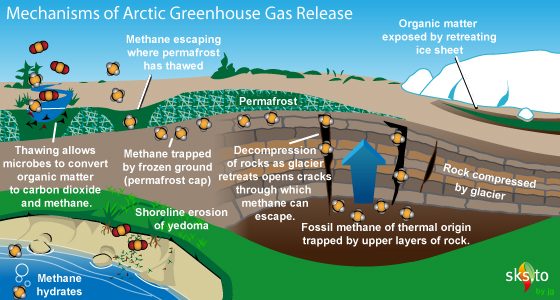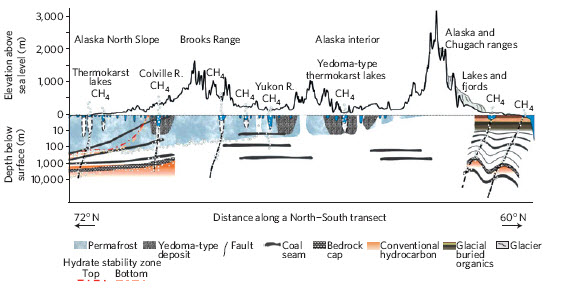Subcap Methane Feedbacks, Part 1: Fossil methane seepage in Alaska
Posted on 28 November 2012 by Andy Skuce
As permafrost thaws, methane is released as the vegetable matter in the soils decomposes. This methane bubbles to the surface in lakes and ponds and accumulates under the ice in the wintertime. New research has shown that the most vigorous methane seeps in Alaska are fed also by methane emitted by thermal decomposition of organic matter in deeper and much older sediments. Continuous permafrost acts as a top seal to this fossil methane, preventing it from reaching the surface and, as global warming melts and perforates this cap, we can expect the pent-up gas to be released more quickly. This source of methane, released from traps under the permafrost, is a potential third source of methane feedback in the Arctic, in addition to permafrost soils and methane hydrates.
One of the big unknowns in forecasting the course of climate change is anticipating how the Earth’s carbon cycle will respond to the coming man-made increase in temperature. The carbon cycle describes the many processes through which carbon flows between stocks of the element in the atmosphere, the oceans, the rocks, the soil, and in plants and animals. The Earth's most sensitive place to changes in the carbon cycle is the Arctic. Not only is this the region with the fastest changing climate and some of the largest stores of carbon, but even small temperature changes there will produce large effects as ice and soils that have been frozen for thousands of years begin to thaw.

Figure 1. Schematic diagram of the many ways that greenhouse gasses can be released as a warming climate in the Arctic leads to collapse of the cryosphere. Most of these will be covered in this series of articles. Graphic by John Garrett.
The permafrost is essentially an enormous freezer, locking away vast quantities of plant matter from participation in biological processes. When global warming removes this vegetable purée from the Holocene refrigerator and places it on the Anthropocene compost heap, it will rot and release carbon dioxide and methane. The infra-red absorbing properties of these gasses will, in turn, cause further global warming.
A recent study by Schuur and Abbott has predicted that, under the four representative emission pathways (to be used for the IPCC fifth assessment), some 232-380 billion tonnes of CO2 equivalent will have been emitted by 2100 from thawing permafrost. That is roughly equivalent to eight to twelve years of emissions from fossil fuel combustion at current rates. A recent modelling study has shown that feedbacks from emissions of carbon dioxide alone (i.e., ignoring methane emissions) from thawing permafrost will increase warming by an average of one-quarter of a degree Celsius by the end of this century.
A second potential source of Arctic methane is from the destabilization of methane hydrates, an ice-like combination of water and methane that forms, and is stable, at a combination of low temperatures and high pressures. Because the largest documented deposits of hydrate are deeply buried, under a few hundred metres of water or under thick permafrost, most scientists believe that it will take time—centuries or even millennia—before they are destabilized by global warming in a major way. Nevertheless, because the quantities are so huge—the amount of carbon in hydrates may be twice as high as the carbon in fossil fuels— and because the mechanisms of destabilization are not well understood, methane hydrates are the subject of anxious attention.
Doffing the cryosphere cap
As if two big sources of Arctic greenhouse gas feedback were not enough, research by Katey Walter Anthony and three colleagues (WA12, paywalled; see also this BBC report and this RealClimate article), recently published in Nature Geoscience, has identified a third: geological or fossil methane seeping out of sediments deep from beneath the permafrost. In this subcap seepage the permafrost acts, not just as an ice-locker containing carbon, but also as an impermeable cap impeding the upward motion of gas from deeper sedimentary rocks to the surface. As this seal thaws and becomes perforated, it allows gas to seep more quickly to the surface.
WA12 identified two additional types of subcap seep and these will be discussed in part three of this series. One involves retreating glaciers and ice caps that cause the crust to bend from the change in loading; this flexing can reactivate faults and open fractures, allowing them to act as conduits for deep gas. The other type is caused in a different way by retreating ice sheets that expose organic matter that was previously overridden and buried during an earlier glacial advance. All of these processes involving melting permafrost and retreating glaciers are lumped together as “cryosphere cap” phenomena.

Figure 2. This is part of Figure 4 in WA12. It is a schematic north-south cross-section through Alaska, illustrating: the topography and glaciers; the depth and continuity of permafrost (light blue) and yedoma (grey; wind-blown silts, rich in organic matter); water bodies (blue) and melt bulbs (white) in the permafrost; coal seams, faults and conventional hydrocarbons; and methane hydrates under the North Slope.
Observing and sampling Alaskan seeps
Katey Walter Anthony and her colleagues conducted aerial surveys in Alaska, searching for evidence of seeps in frozen Arctic water bodies (lakes, rivers and fjords).They backed up this reconnaissance work with ground observations by measuring seep rates and taking samples of the bubbling-up gas. Faster-bubbling seeps stir up the water more, keeping the holes in the ice on the surface of the water bodies open longer during the winter. They are thought to be associated with gas coming from below the permafrost and are called "subcap seeps". In contrast, superficial seeps (from biological processes within the permafrost itself) would be expected to bubble-up more slowly and form smaller holes in the winter ice. These holes freeze over more quickly, trapping methane bubbles within and below the ice.
The video shows some examples of superficial methane seeps—and the eyebrow-singeing fun that can had be with them.
There are a variety of analytical techniques available to determine the age and origin of the methane gas.
First, unstable carbon-14 isotopes can determine the age of the organic material that was the origin of the methane. Most of the subcap methane seems to be more than 50,000 years old, older than the last glacial maximum and perhaps much older.
Second, stable isotope ratios of carbon-12/carbon-13 and hydrogen/deuterium provide a fingerprint of the way the methane was generated, with biological methane being more depleted in the heavier isotopes than the fossil/geological methane, which was formed at depth by chemical processes at higher temperatures and pressures. Much of the subcap methane appears to have had a deep source like this.
Third, measuring the proportion of ethane and propane in the gas samples allows them to be compared with samples of gas from nearby natural gas wells; again supporting the idea that the subcap methane is of a deep, fossil origin. Some of the subcap gas showed signs of mixing with shallow biological gas as it made its way to the surface. The superficial seeps, on the other hand, were exclusively of biological origin.
These factors, taken together, strongly suggest that the most active seeps in Alaska result from the bubbling up of methane from deep, old geological origins rather than methane produced by biological decomposition of younger organic matter. This is important because this fossil methane provides a third source of potential greenhouse gas feedback in the thawing Arctic, in addition to the permafrost and methane hydrate sources.
Geographical distribution of the subcap seeps

Figure 3. An extract from Figure 2 in WA12, showing the distribution of subcap seeps in relation to permafrost regions; present and past glaciations; and locations of coal and petroleum deposits. The legend was edited from the original to exclude references to features not shown in this extract. Original figure is here.
If the gas in the fast seeps does indeed come from deep geological sources, then the distribution of these seeps should show a pattern. For example, the large subcap seeps related to permafrost should be located in the continuous permafrost area of northern Alaska, in areas where the geography and near-surface geology allows the formation of thaw bulbs, or near the boundary between the continuous and discontinuous permafrost. In the discontinuous permafrost area of central Alaska, seeps should be predominantly superficial, with subcap seeps being small and rare. Also, subcap seeps need to be fed from below, which means that they should overlie sedimentary basins that contain petroleum source rocks or coal. Generally speaking, this is borne out, as shown in Figure 3.
Surface seeps of fossil methane (and oil) have long been recognised in Alaska and elsewhere around the world. The contribution of Walter Anthony and her colleagues is to have quantified the Alaska gas seeps and to have provided us with evidence and criteria to distinguish fossil methane seeps from seeps of younger, biological methane that occur in the areas of thawing permafrost. In the next part of this series, we'll look at the significance of the Alaskan subcap seeps in the context of other permafrost-related seeps of methane and geological sources of methane in other parts of the Arctic and compare them to geological seeps observed elsewhere on the planet.































 Arguments
Arguments























 0
0  0
0






Comments